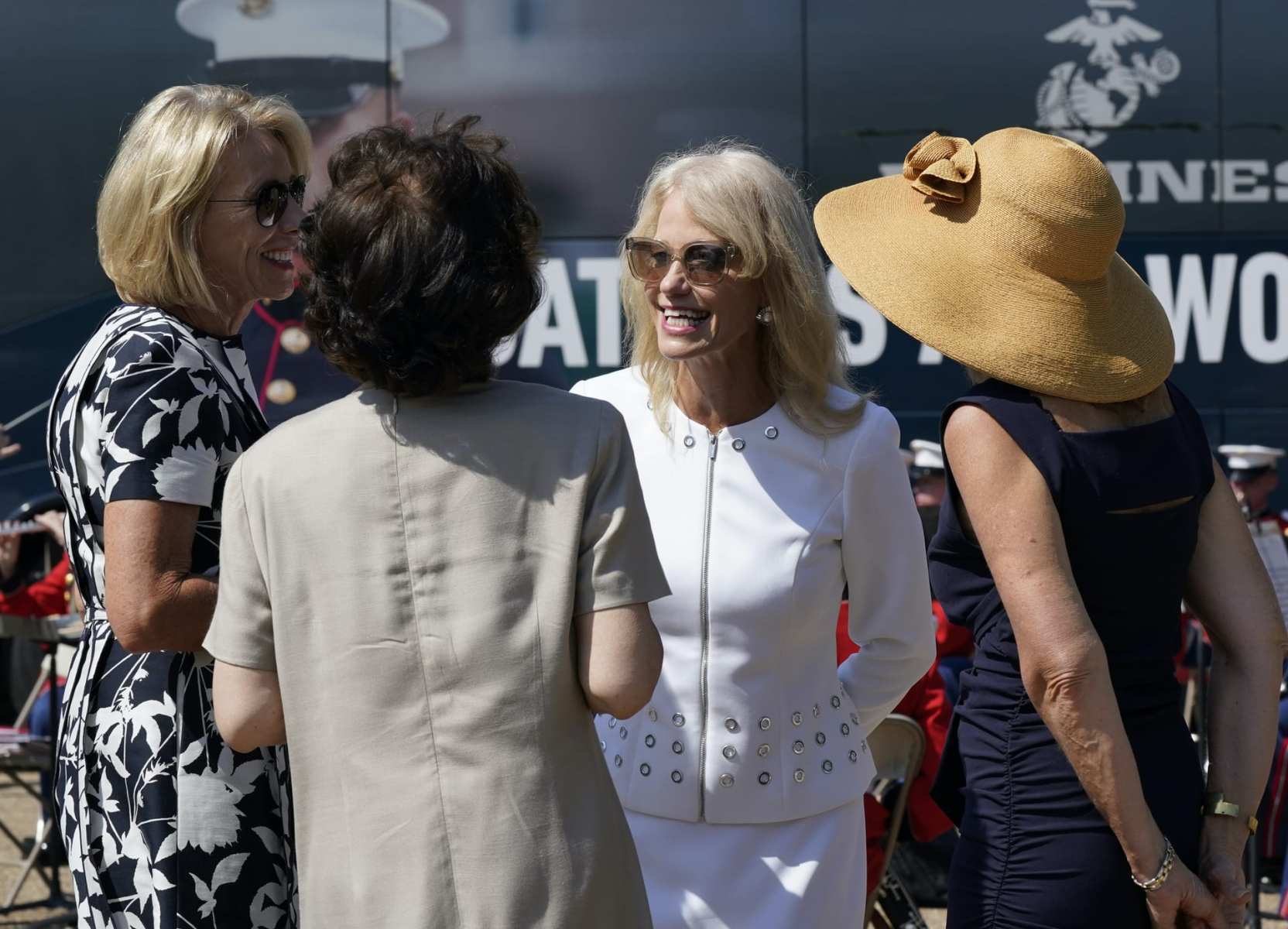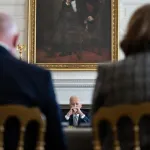During the Republican National Convention, the high-ranking women in Donald Trump’s White House tried to make the case for the president’s commitment to gender equality.
Outgoing adviser Kellyanne Conway called him “a champion for women.” Brooke Rollins, acting director of the Domestic Policy Council, went further, saying Trump has more women in his top team “than any president before.”
A video flashed through images of women who advise the president, including his daughter Ivanka Trump and his daughter-in-law, Lara Trump. A voiceover intoned: “President Trump has proven that when the stakes are highest, he is proud to entrust many of our nation’s most crucial jobs to women.”
The rhetoric, however, belies the reality in the Trump White House, particularly when it comes to the gender pay gap, a key measure of gender parity.
An analysis by The 19th of the 2020 median salaries in the Trump White House found a $33,300 chasm between the median salary for male staffers ($106,000) and the median salary for female staffers ($72,700).
That means women make nearly 69 cents on the male $1 — worse than the national gender pay gap of 82 cents on the dollar.
The numbers reflect what economists call the “raw” gender pay gap, meaning they don’t adjust for experience, education, title or other factors. The national figure is also a reflection of the raw gender pay gap. Neither is a full representation of the entire picture, leaving out the complexities of persisting occupational segregation and the challenges of access that still plague women trying to move up to positions of leadership.
But stacked against each other, they do show a persisting pay gap between men and women. (The Trump administration does not appear to have any staffers who identify as nonbinary, according to the National Center for Transgender Equality).
“To avoid addressing structural and institutional gender discrimination in terms of pay equity, the go-to is to talk about position and title when, in fact, that’s not what’s driving pay inequity,” said C. Nicole Mason, the president and CEO of the Institute for Women’s Policy Research. “It’s decisions that are being made from the top down about the valuing of women’s work and how much they should be paid.”
The issue of pay inequity has plagued past administrations too. Women in President Barack Obama’s White House were paid between about 84 and 89 cents for every $1 paid to male staffers, though that gap was narrower than the one in the Trump White House and narrower, too, than the national gender pay gap in those years.
The gender pay gap widened from 89 cents on the dollar in 2016 during the final year Obama was in office, to 63 cents on the dollar the first year Trump was in office, according to an analysis by the American Enterprise Institute, a conservative think tank.
The Trump White House salaries are current as of June 26. The numbers have been reported annually to Congress on July 1 since 1995. The White House did not comment on the gender pay gap but did provide data on average salaries, which have increased by 7.1 percent for female staffers between 2017 and 2020, while decreasing for male staffers by 0.6 percent.
In a statement, press secretary Kayleigh McEnany said the president “implements policies that empower women across the country,” and highlighted some of the milestones that occurred during the Trump administration, including a historic low unemployment rate for women in 2019 (though female unemployment has since hit a historic high following the coronavirus pandemic); the passage of paid family leave for federal employees; the passage of a child care tax credit (which has been criticized for not helping those most in need); and the establishment of the Women’s Global Development and Prosperity Initiative, led by Ivanka Trump.
The White House also noted that half of the senior leaders in the National Security Council are women.
“President Trump has taken unprecedented action to support women and girls,” McEnany said.
The Trump administration has also said that it has more women in senior positions than any president in history. But an analysis by The 19th of its commissioned officers — assistants, deputy assistants and special assistants to the president (the highest rank) — found that about 40 percent of staffers with that ranking in the Trump White House were women.
In the 2016 Obama White House, which had a larger overall staff, the gender split in top positions was 50–50.
A Brookings Institution analysis of top advisors across administrations found that the 2017 Trump administration had women in 23 percent of its “A” team positions, what Brookings defines as the most influential staff members. That’s less than the 2009 Obama administration, the 2001 George W. Bush administration and the 1993 Bill Clinton administration.
Democratic presidential candidate Joe Biden’s campaign did not provide its salary breakdown by gender, but said 59 percent of its full-time staff is female, and 56 percent of its senior staffers are women.
Mark Perry, an economist and scholar at the American Enterprise Institute who has closely tracked the gender gap figures during recent years, said some of the disparity in pay in various administrations can be explained by looking at the spread of male and female staffers by seniority.
Federal guidelines dictate the salary brackets by type of position, so men and women performing similar jobs can expect to be paid about the same.
But more women are being hired into entry-level positions, Perry said, which is in line with the increased number of women who are graduating college as compared to men — nearly 58 percent last year.
“More women than men have the college degrees that would get them the credentials to get a job at the White House as a low-paid staff person,” Perry said.
At the higher end, there are more men than women who have advanced degrees and decades of continuous experience in politics, he said.
“That labor market for people with 30 years continuous experience in Washington … there were just naturally more men than women in that labor market,” Perry said.
There is no absence of qualified women.
C. Nicole Mason, the president and CEO of the Institute for Women’s Policy Research
But that also paints an incomplete picture, said Mason with the Institute for Women’s Policy Research.
“There is no absence of qualified women,” Mason said, adding that the Obama administration did make a stronger commitment to hiring women in senior leadership positions.
In 2016, for example, more women than men earned $100,000 or more in the Obama White House — about 53 percent of six-figure earners compared to nearly 47 percent who were men. In 2020, the gender split among the highest earners in the Trump White House was 37 percent female and 63 percent male.
Among the top female earners in the White House were Conway, Rollins, McEnany, aide Hope Hicks and the first lady’s chief of staff, Stephanie Grisham, who all made $183,000. Ivanka Trump and her husband, Jared Kushner, do not take a salary in their White House roles.
Among the lower earners, Mason said that there is some discretion as to what aides get paid — even within federal income brackets.
“That is probably the biggest explanation for the widening of the gap within administrations,” she said.
And then there’s the talent pool. Fewer women are Republican than men, and fewer conservative women work in politics, which has posed a challenge in terms of getting Republican women elected to office. But it doesn’t explain away entirely the issue for the 400-plus positions available at the White House — there are enough qualified women to fill those spots, said Kelly Dittmar, director of research and scholar at the Center for American Women and Politics at the Eagleton Institute of Politics.
The bigger explanation lies in the party’s ideological approach to issues of diversity. The argument in terms of hiring is often that there are certain people in the top positions simply because the best person was chosen for the job from a limited selection.
That argument resonated during the Republican National Convention’s appeal to women.
“I don’t want a job because of my gender,” said adviser Kimberly Guilfoyle. “I want the job because I’m the best person for that position.”
It’s a different ideological approach from a growing sentiment in the Democratic party that a demographic identity provides its own value.
“If you’re talking about who you want at the decision-making tables in the White House, you would put a value on women’s voices not because of their biological sex, but because that gender identity brings with it a distinct lived experience and perspective as women in a society in which gender is one axis of inequity and power,” Dittmar said.
There’s also a partisan difference as to whether the gender wage gap is an issue that requires urgency or whether it’s a myth.
“If you can just say the gender wage gap isn’t a thing or discount it in other ways, you don’t even get into the nitty gritty of the data,” Dittmar said.
Trump also hasn’t put closing the gender pay gap as a major priority of his, though it is a priority for Ivanka Trump. The president has also tried to roll back measures designed to increase transparency on pay data. In 2017, the Trump administration stopped the Equal Employment Opportunity Commission from collecting pay data on gender and race from companies with 100 or more employees — a rule instituted during the Obama administration to illuminate inequalities in pay. A federal judge ruled last year that the Trump administration failed to prove the move would put undue burden on employers, and ordered the EEOC to continue collecting the data.
“The Trump administration has shown no interest in taking steps to close the racial and gender wage gap impacting working women across this country,” said Emily Martin, vice president of education and workplace justice at the National Women’s Law Center, one of the groups that sued the Trump administration over its freeze on collection of the pay data. “It’s no surprise that the wage gap is not only larger in the White House than the rest of the country, but is moving in the wrong direction.”
The president also signed an executive order in 2017 that rolled back the Obama administration’s Fair Pay and Safe Workplaces executive order, which required companies with federal contracts to comply with 14 labor and civil rights laws, including a paycheck transparency rule. The Trump administration’s main concern with eliminating the order centered on a provision that required federal contractors to report labor violations, something Republicans in Congress argued could be used as “blackmail” in labor union negotiations.
Going into the 2020 election, the president has made a more direct push to highlight his support of women. On the centennial of the ratification of the 19th Amendment, which gave some women the right to vote, Trump issued a proclamation making August 26, 2020 Women’s Equality Day.
“Recognizing that women contribute to the strength and security of our Nation, my Administration will always make supporting women and working families a top priority,” the president wrote.
In the polls, Trump trails Biden on the female vote by double digits.
The Republican National Convention attempted to close that margin, featuring a line-up with numerous female speakers who spoke to the president’s commitment to women.
But the rhetoric, Mason said, isn’t matching up with the president’s priorities.
“Women across America need to ask some tough questions,” Mason said. “Do the president’s positions, views and behaviors reflect their values?”
The 19th’s Washington correspondent, Amanda Becker, contributed to this report.






